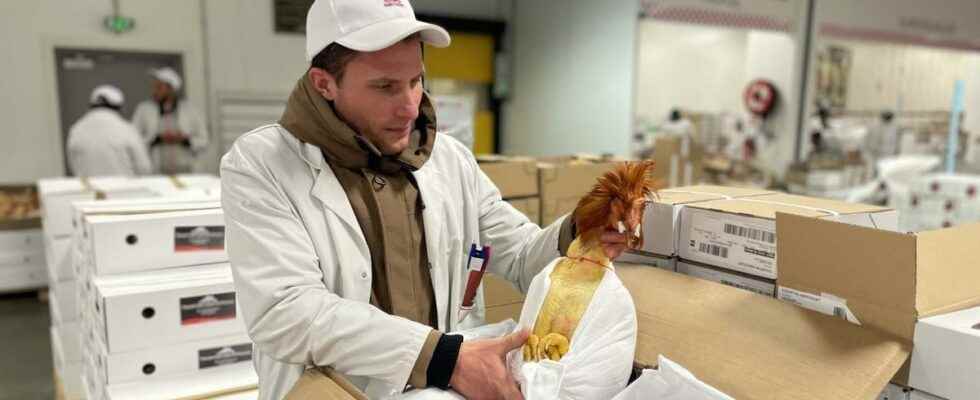REPORT – A few days before the holidays, turkeys, oysters and fir trees are selling as best they can in Europe’s largest fresh produce market.
“The turkey is cooked!“. Both ends of the lips stretched, Santa Claus from Rungis, arm in arm with a clerk in a white coat holding a chicken in the other hand, smiles in front of the objective. It is 4:30 am, and the international market is in turmoil. Three days before Christmas, butchers, delicatessens and caterers are busy finding the most beautiful pieces in the “poultry pavilion“. It reigns in the huge hall decorated with luminous garlands like a festive air.
Under the joyful appearances however, the concern is there on this December 22. “Look around you: it’s 7 o’clock, and there’s hardly anyone left. Normally, in this season, we work well until 9am!», points out a stand manager. “We expected ithe continues, scanning his stacked boxes of capons, guinea fowl and chickens. Report on rising prices. People buy less. They are careful“.
Read alsoInflation could hold up
The international market of Rungis, kingdom of restaurateurs and traders, is the largest fresh produce market in the world. You find things here that you don’t see anywhere else. Like this gratin dauphinois with truffles, ready to be reheated, a restaurant owner in his fifties explains with a smile. Here, the holiday season is the most important. In one month, merchants must make about 30% of their annual turnover. “Everything is played from December 19 to 22confirms a fishmonger at Figaro. If you miss this period, you miss the whole year“.
This is where the concern comes from, palpable, in this universe with the smells of fresh fish, rare meat and fir trees. At “La Marée”, the seafood hall, size 3 oysters are 10% to 15% more expensive than last year. Will inflation be fatal for sales? “As my products can only be bought at the last minute, I will be fixed on Saturday noon», replies Icham, stand manager. A bad signal, however:Usually, we have orders in advance for lobsters, crayfish, cakes for the festive lunch… This year, we don’t have anyhe laments. We’ll see. It will be poker“.
When bird flu spoils the party
Some time later, we find Santa Claus, leaning on the bar of the Saint-Hubert bistro, at the entrance of the Poultry pavilion. The brasserie is already full at 7:30 am, filled with men in bloodstained white coats who are already midday, sipping some coffee, some half a Heineken. “Already it was necessary to restart the machine after two years of Covid, now bird flufalls on us», slips a wholesaler to his neighbor. 50% of its foie gras producers provided it with nothing. “They didn’t even send a duck, zero“. “Avian flu has already plagued 2023“retorts another.
Europe has been dealing with the avian flu epidemic for more than a year.the most devastating” never observed on its soil, with around 50 million poultry slaughtered in farms infected with the virus, according to health authorities. Gino Catena, who heads the syndicate of poultry and game wholesale commissioners, is however optimistic. “It’s a matter of organization, but you can always find new producers“, he assures.
This veteran wearing a cowboy hat knows what he’s talking about. Here it is considered “leader“. “Look at this beautiful foie gras: slaughtered the day before, shipped overnight, sold the next day“, he demonstrates. Rather confident about his turnover, Gino is waiting for the New Year to “say mass“, in other words, to do the accounts. “Until then, there is still hope!“, he wants to believe.
The abandoned trees
For their part, the cheese makers are doing well. Even if the purchase price for small producers rises between 15 and 20% with the cost of raw materials, the Covid-19 has caused cheese consumption to jump. Yves Cremmer, who for 20 years has been running the “Odéon” site for dairy products, has tripled his turnover. “The French are still fond of old Comtes and cooked pasta for Christmashe notes. There is one cheese in particular that surprises me every year: Roquefort. Its sales explode at the end of December, to believe that it is on all the tables! Conversely, the camembert is neglected, as if it passed for a rather everyday cheese“.
In the flower building, a sweet air of jinglebell reigns in the hall. Hyacinths and winter roses brighten the view with a thousand colors. Two nuns stroll behind a cart. They are on the lookout for abandoned flowers to adorn the altar at Midnight Mass. Heaps of fir trees lie piled up here and there. Haven’t they found takers? “Trees have not been sold for a long time“, sighs William, accompanied by his teenager, who holds the stand with him during school holidays: “If we only sold that, it wouldn’t be enough to pay for our stand at Rungis“.
No, Christmas trees no longer sell so well, confirms Frédéric Béguin, manager of the PlantAssistance brand at Rungis. Blame it on the environmental movement, he suggests: “From you to me, we feel that something has changed with our customers. I can’t explain it, but it’s as if the magic of Christmas wasn’t quite there.“.
